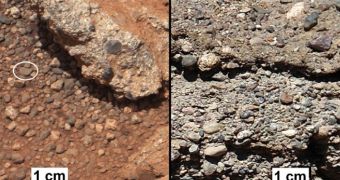Mission controllers at the NASA Jet Propulsion Laboratory (JPL), in Pasadena, California, announce that the Mars Science Laboratory (MSL) rover Curiosity has discovered an ancient riverbed inside Gale Crater, through which it currently roams on the Red Planet, heading for Mount Sharp.
The purpose of the MSL mission is to figure out whether or not liquid water flowed through the crater, and if the location was ever capable of supporting life in any form. Thus far, signs look encouraging.
At the center of Gale Crater, the 5-kilometer (3-mile) tall Mount Sharp towers over the surrounding landscape. The mountain developed when an asteroid impact ejected massive amounts of materials high in the Martian atmosphere. When the material settled, it created this huge landscape feature.
Curiosity touched down at Bradbury Landing, a location relatively close to Mount Sharp's gentle slopes, and has been driving towards it ever since. It is currently closing in on an outcrop called Glenelg, its first important science target.
While en route, JPL experts asked the rover to analyze several formations on the ground. During one of these stops, the robot's cameras were able to identify telltale signs that a riverbed once existed here.
The similarity between the streambed gravels that Curiosity found on Mars and similar materials on Earth is striking, experts say. The rover returned a series of images showing gravels embedded in other types of rocks. These photographs are the first of their kind.
“From the size of gravels [the ancient river] carried, we can interpret the water was moving about 3 feet per second, with a depth somewhere between ankle and hip deep,” expert William Dietrich explains.
“Plenty of papers have been written about channels on Mars with many different hypotheses about the flows in them. This is the first time we're actually seeing water-transported gravel on Mars,” he says.
“This is a transition from speculation about the size of streambed material to direct observation of it,” adds the expert, who is a science co-investigator for the Curiosity rover. He is based at the University of California in Berkeley (UCB).
In a statement released on Thursday, September 27, NASA scientists say that the ancient riverbed lies at a location between the north rim of Gale Crater and the base of Mount Sharp. The most remarkable thing about this finding is that it increases the chances of finding signs of past life on Mars.

 14 DAY TRIAL //
14 DAY TRIAL //